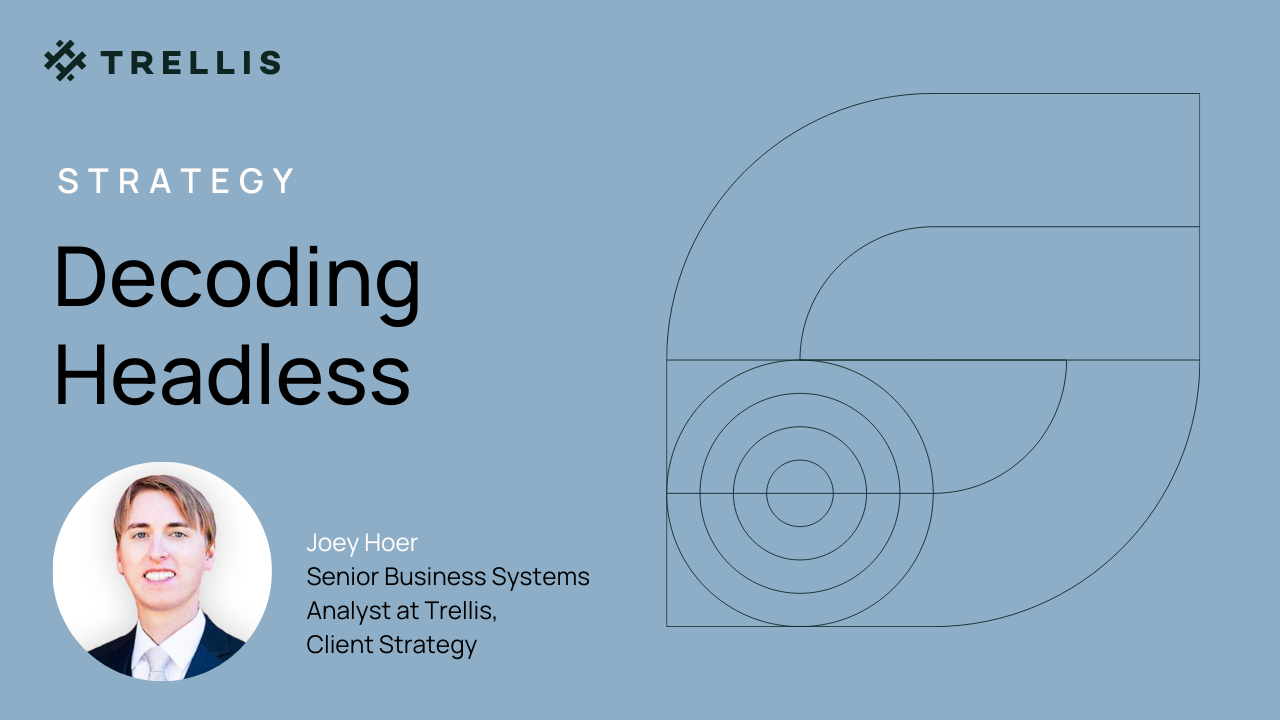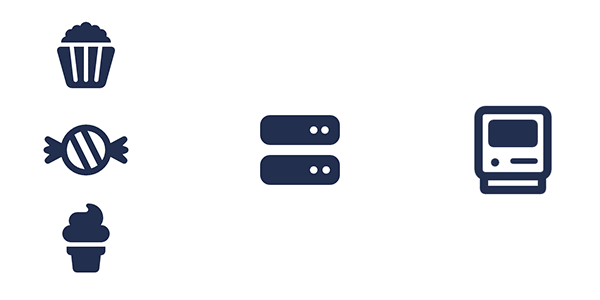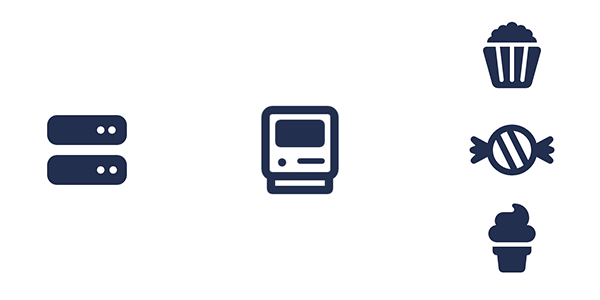The term “headless” is increasingly capturing the attention of eCommerce business owners and decision-makers. But what does headless architecture mean, and how do you know if headless is the right choice for your business? Let’s explore the intricacies, dispel myths, and guide you through deciding if headless fits your digital strategy.

What Exactly Is Headless Architecture?
The term “headless” generally refers to a system architecture where the backend (the body) is decoupled from the frontend (the head). This setup allows the backend, which handles data management and business logic, to serve content to a variety of frontend interfaces, such as websites, mobile apps, digital kiosks, or IoT devices. Such flexibility enables a single backend to support multiple frontends, providing access to the same data and functionality across all user interfaces.
In a more specific context, a “headless website” represents just one of potentially many frontends that connect to the same backend(s). Importantly, a headless architecture also allows each frontend to connect to multiple backends or APIs. This capability is particularly useful because it allows the frontend to pull diverse data and functionalities from various services. It is a common and powerful approach in modern web development. This versatility makes headless architecture highly adaptable and scalable, suited for businesses looking to leverage complex, multi-source data integration seamlessly.
Common Misconceptions About Headless Architecture
Headless architecture offers exciting possibilities for businesses looking to leverage technology for flexible, multi-platform content delivery. Yet, it’s not without its complexities and considerations. By better understanding the capabilities of both headless and headful architectures, businesses can make informed decisions. They can choose the solution that best aligns with their business objectives and digital strategy.
Despite the widespread use of the term “headless,” several misconceptions exist. These misconceptions can affect how the technology is perceived and influence its adoption.
Client-Side vs Server-Side Rendering
Understanding rendering is essential to understanding a key technical differentiation between headless and headful websites.
“Rendering” refers to how content and data are displayed on a website’s front end. Although there are several rendering methods, we’ll focus on two main types: “server-side rendering” (SSR) and “client-side rendering” (CSR).

Server-Side Rendering
In server-side rendering, all of a page’s content is delivered in a single response from the server. Here’s how it works: The user makes a single request to the server. The server aggregates all the necessary data, possibly from various systems or services through multiple backend requests. It then sends back everything needed to display the page.

Client-Side Rendering
In client-side rendering, the server initially responds with just a “shell” of the webpage. The content then loads dynamically as needed. Here’s how it works: The user requests the page, and the server sends back the basic shell of the application. After this, the frontend makes one or more additional requests for specific content. As each piece of content is received, the corresponding elements of the user interface are dynamically rendered and displayed.

Headful websites are capable of rendering only native content server-side. Any data or functionality not provided by the SaaS platform’s theme engine, such as access to third-party APIs, custom databases, or other services, must be either rendered client-side or hosted externally. Essentially, headful websites on SaaS platforms use a hybrid rendering approach. The native content is rendered server-side, while the non-native content is rendered client-side.
Comparatively, modern headless frameworks such as Next.js support both client-side and server-side rendering. The trend in recent years has favored maximizing server-side rendering. However, headless architecture offers the flexibility to select the best rendering method for each element of the user interface.
The decision to use server-side or client-side rendering depends on specific project needs, goals, and the desired user experience. While headful themes meet the needs of many businesses, headless architecture provides a valuable alternative for those seeking complete control over their content rendering.
Customization Limitations
While engineers praise headless architecture for its customizability, it’s crucial to distinguish between “presentational” and “functional” customization.
Presentational customizations refer to the “look and feel” of a website. This includes the styling of elements, which may involve animation and interactivity. You can define presentation by HTML, CSS and JavaScript and equally customize it within either architecture. In this regard, headless websites and headful websites are no different. Both architectures offer the same capabilities for presentational customization.
Functional customizations on the other hand usually refer to features which require access to data structures. As previously discussed, both headless and headful websites can access non-native data structures. The only difference lies in how they access that content. Headless websites can render this content server-side or client-side, while a headful website must render this client-side. In either case, the underlying implementation will leverage the same APIs to access the content.
The main constraint of a headful system is its inability to directly alter the native data model and functionality of the underlying SaaS platform. Such changes require an “app”.
This functions similarly to a headless endpoint. It uses the SaaS platform’s APIs and custom logic to introduce new or augmented functionality that the platform does not directly support. When you require this level of customization, a headless architecture should be considered.
Both headless and headful architectures can achieve high levels of presentational and functional customization. Headful websites meet the needs of many businesses. However, websites excel in specific functional customizations, such as modifying native data models or functionality. They are not constrained by the strict standards that govern headful websites.
Performance Perceptions
Misunderstandings around how rendering impacts perceived performance often feed into the broader misconception that headless websites automatically guarantee superior performance. In reality, both headless and headful systems can deliver high performance, with neither being inherently superior. The performance of each architecture largely depends on its implementation.

Why headful websites may seem less performant?
Headful websites may seem less performant than their headless counterparts because they use client-side rendering for non-native content. While the difference between server-side and client-side rendering might not be noticeable on fast internet connections, it becomes apparent on slower ones. Client-side rendering can feel slow and error-prone if the UI is unresponsive while users wait for content to load. However, implementing a “skeleton UI” that loads content incrementally can enhance the perception of speed. This method displays the basic page structure first and fills in details progressively. A thoughtful implementation of client-side rendering can lead to websites that appear to be lightning fast.
Another reason headful websites might seem less performant than their headless counterparts is that SaaS platforms typically bundle some amount of JavaScript in their theme engine, which cannot be removed. Despite this, these assets are not usually the primary cause of slowdowns. Headful platforms maintain speed through built-in performance optimizations. These include automated asset compression, browser caching, cache busting, and CDN integrations.
Why businesses choose SaaS platforms?
Because the platform fully abstracts and provides headful infrastructure as a service, businesses do not need to employ DevOps resources to manage their infrastructure. This reduces the need for in-house maintenance, as the responsibility shifts to the platform’s experts who ensure the infrastructure is optimized. This is a key reason why businesses choose SaaS platforms, as managing infrastructure in-house can be costly and risky. Instead, platform experts handle these tasks. They deploy and maintain the infrastructure, ensuring it remains at the cutting edge of performance-enhancing technology.
Similarly, headless architectures can achieve comparable benefits through managed PaaS solutions like Vercel and Netlify. These platforms use serverless technologies to handle infrastructure. These platforms automate much of the system management, making headless setups more accessible and less reliant on traditional DevOps roles. Nevertheless, implementing headless infrastructure requires careful consideration to choose appropriate technologies. Ill-informed decision-making can significantly affect both cost and performance.
A recent report generated by Shopify found that “headless is performant only when implemented well,” and we can say the same about headful websites. The performance of a website depends on the time and attention dedicated to performance optimizations; therefore, no architecture inherently performs better.
SEO Sophistication
Headless websites are often touted as better for SEO, largely because they can leverage server-side rendering, which is generally regarded as more SEO-friendly. Client-side rendering relies heavily on JavaScript, which can pose challenges for search engine indexing. Historically, search engines have struggled to effectively index sites that rely on JavaScript rendering. Although indexing technologies have improved, websites using client-side rendering can still face SEO difficulties if not implemented carefully.
While headless architecture might offer some SEO advantages for integrating non-native content due to its flexible rendering options, both headless and headful websites can effectively optimize native content for search engines. Ultimately, the success of a website’s SEO efforts depends more on the quality and uniqueness of its content and how well you execute the SEO strategies, rather than the choice between headless and headful architectures.
Scalability
Headful websites benefit from access to app stores, which provide easy access to a range of extended functionalities, enhanced customization, and the prebuilt integrations with third-party services. These app stores offer cost-effective solutions that help businesses scale and integrate new technologies effortlessly, without requiring extensive technical knowledge or significant investments in R&D.
These apps are made possible by the SaaS platforms’ theme engine, which offers standardized integration methods that enable third-party service providers to easily create plug-and-play connectors. These standards also safeguard security, performance, and a well-tested user experience that has proven optimal for conversion.
Integration & Upgrades
Third-party service providers are encouraged to create apps for SaaS platforms in order to gain access to the SaaS platform’s extensive user base. In turn, SaaS platforms are driven to improve their theme engines and promote app adoption, as their app ecosystem creates additional revenue streams. As a result, SaaS platforms and app vendors release updates regularly, continuously expanding the capabilities of the platform with ever more built-in and app-supported features. Headful websites can benefit from platforms and app updates and upgrades at no extra cost.
While prebuilt headful apps are a development optimization which streamline development by facilitating more efficient system integration, the absence of a prebuilt app within a headful platform does not preclude the possibility of creating a custom integration. In fact, a custom headful integration would leverage the same underlying technology as a headless integration.
While headless websites lack access to the pre-built integrations available in headful systems, they are not bound by the standards that headful integrations enforce. Therefore, they can integrate with any system by any means necessary. Such custom integrations must also be maintained as vendors introduce new technologies.
In terms of scalability, businesses need to decide what matters more to them: access to prebuilt integrations that lower costs but must adhere to the standards enforced by the SaaS platform, or the ultimate flexibility in customization despite the associated higher costs.
Simplifying Replatforming?
When evaluating the impact of headless on rethemeing, it’s important to differentiate between “replatforming” and “retheming.” Replatforming involves replacing the platform (backend system), whereas retheming involves replacing the frontend interface.
When using a headful implementation, a replatform also necessitates a retheme. However, with headless architecture, theoretically, replatforming doesn’t require retheming, as your website’s design (HTML, CSS, and JavaScript) could remain unchanged, with only the “connector” to the backend API being replaced.
However, replatforming a headless website is not always straightforward. Different platforms are unlikely to have interchangeable APIs with exactly the same schema, potentially resulting in misalignment in how the frontend interacts with the new backend. Modern headless frameworks aim to address this issue with a standardized data schema, though it’s not always certain that every platform will fully support the data or functionality without also requiring some frontend adjustments.
Therefore, while headless architecture offers theoretical advantages in simplifying replatforming, the practical application can be complex.The frequency of these changes and the associated costs also play crucial roles in deciding whether a headless solution is suitable for your business. Businesses should carefully balance these considerations with the flexibility that a headless architecture provides when determining the most strategic approach for maintaining and evolving their websites.
Is Headless the Right Choice for You?
Ironically, the mythological hydra with many “heads” (frontends) for a single “body” (backend) is a suitable metaphor for envisioning a modern headless architecture. The ability to support multiple heads is a significant draw, especially for businesses aiming to deliver content seamlessly across multiple platforms. However, if multiple heads are not required, this architecture may be underutilized in terms of its potential for scalability and flexibility across multiple platforms. For projects well-served by the integrated frontend-backend solutions of a headful website and where no expansion to multiple platforms is anticipated, the additional effort and expense of adopting a headless architecture might not be justified.
The decision to use a SaaS platform is usually based upon the value which standardization and normalization afford. These standards are sometimes characterized as “limitations”, yet they are pivotal for enabling a robust SaaS ecosystem which includes third-party apps, managed security, hosting, and performance optimizations, and an enhanced overall user experience. SaaS platforms offer merchants affordable access to extensive resources created and maintained by experienced professionals. SaaS platforms also provide ready-made solutions that cover a broad spectrum of business needs, thereby reducing complexity and risk for merchants.
Choosing a headless approach means moving beyond the standardized frontend-backend solutions offered by SaaS platforms, but it doesn’t necessarily imply abandoning the benefits of SaaS altogether. Although headless architecture doesn’t require a SaaS backend—since any platform or custom solution can act as the backbone—many businesses still integrate various SaaS services like commerce engines, CMSs, and ERPs into their headless setups. This way, even without utilizing a SaaS platform’s theme engine, businesses can still enjoy some of the advantages of SaaS platforms, such as scalability, security, and ongoing support.
Headless isn’t a one-size-fits-all solution. It demands a robust understanding of your organizational needs, resources, and long-term digital strategy.
Consider headless if:
- You seek the flexibility to switch platforms with minimal impact on the user experience.
- You cannot achieve the desired functionality given the limitations enforced by headful standards.
- Your digital ecosystem spans multiple user interfaces requiring a shared backend.
- You’re ready to invest in custom solutions that outperform standard offerings.
Conversely, headless might not suit you if:
- You lack experienced tech leadership familiar with the software development lifecycle.
- Your budget is limited, as achieving your goals via a headful implementation is generally more cost-effective.
- Long-term maintenance of a headless system is beyond your capacity.
Conclusion
The comparison of headless versus headful is not a question of one being superior to the other, but rather of understanding the trade-offs and strategic opportunities which each option presents. While a headless website may have a higher “upside” by offering greater potential for customization, realizing and sustaining those benefits require considerable resources. On the other hand, a headful website can lower operating expenses by fully utilizing the advantages offered by SaaS platforms, albeit with certain constraints.
| Headful website | Headless website | |
| Cost of implementation | $-$$$ | $$$-$$$$ |
| Cost of maintenance | $-$$ | $$-$$$ |
| Client-side rendering | ✓ | ✓ |
| Server-side rendering | ⚠ only for native content | ✓ |
| Presentational customization | ✓ | ✓ |
| Functional customization | ⚠ occasionally limited to client-side rendering | ✓ |
| Page speed (perceived performance) | ⚠ dependant upon investment | ⚠ dependant upon investment |
| SEO | ⚠ possibly more challenging for non-native content | ✓ |
| Scalable / future-proof | ✓ | ✓ |
| Retheming cost | $-$$$ | $$$-$$$$ |
| Replatforming cost | $-$$$ | $-$$ |
| Requires technical acumen | ✗ | ✓ |
In essence, the choice hinges on the specific needs, capabilities, and long-term vision of your business. Whether you prioritize the customization potential of headless or the streamlined efficiency of SaaS, the goal remains the same: to build digital experiences that serve your business needs and delight your users.
If you’re looking to harness the power of headless commerce and need a partner who can translate this architecture into tangible business success, reach out to Trellis. Let’s start a project today.
Leave a Comment